Pembrokeshire: Empty 200-year-old cottage frozen in time
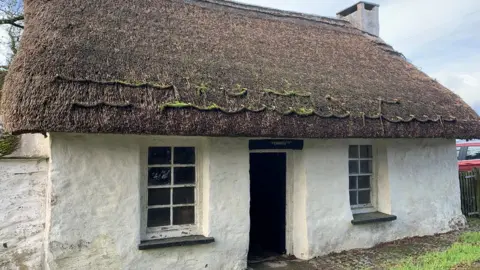 BBC
BBCStepping over its threshold is like journeying back through the centuries.
Set on a lonely country road, Penrhos Cottage is a rare surviving example of an ancient Welsh home-building tradition.
It ruled if someone could build a house on common land between dusk and dawn and have a fire lit in the hearth by first light it was legally theirs.
They would also own all the land within an axe throw of the front door.
Now the locals want to help safeguard this 200-year-old whitewashed thatched property near the village of Llanycefn by forming a new group to attract funding and volunteers.
Currently owned by Pembrokeshire council, this example of tŷ unnos - which translates into English as house in one night - was commonplace across Wales between the 17th and 19th centuries.
It was probably built at some time around 1800 and later rebuilt in stone and clom - a mixture of clay, mud and straw - in 1849.
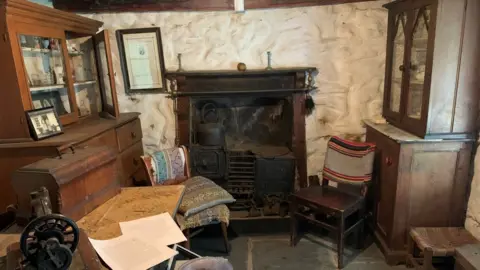
Houses like this would normally be replaced by a more permanent structure, once the builder's claim to the land had been established.
Empty now for decades, it was once home to a family as large as 12, despite initially consisting of just two rooms - the kitchen/living area and the sleeping quarters.
Cooking was done on a tiny range in the kitchen, while electricity was only installed in the 1960s.
It was last occupied by elderly sisters Maria and Rachel Williams, until 1968 when Rachel died aged 82 and Maria moved into a home in Narberth.
Maria worked as a midwife in the community and helped with the birth of many local children, while Rachel spent her days looking after the home.
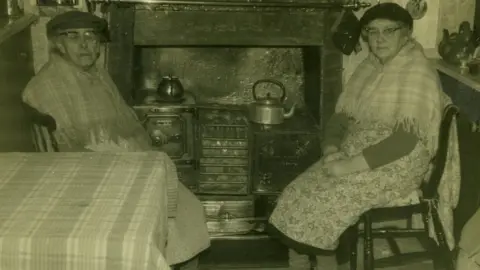 Pembrokeshire Museum Service
Pembrokeshire Museum ServiceThe two sisters lived a simple life at Penrhos and their supply of water was winched up every day from a well to the rear of the cottage, normally with some help from their neighbours at Blaensawd Farm.
The two old ladies and their cottage became something of a tourist attraction.
Eifion Evans, 67, used to live on the farm next door and remembers the pair's kindness.
"I have great memories from when we were little kids," he said.
"We used the catch the bus outside and come up here beforehand to say hello to Maria and Rachel.
"In the afternoon when we came from school they'd have a big box of sweets and there'd be a sweet for each of us, or a little biscuit or chocolate.
"They were two very kind sisters and very fond of children - I consider myself to be one of Penrhos' children.
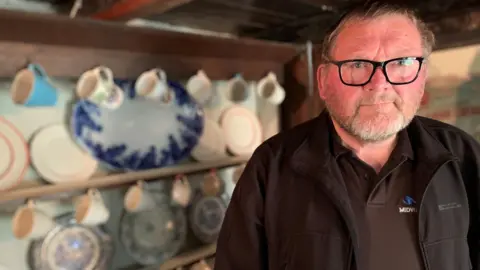
"They had chickens and a little garden in which to grow vegetables.
"It was a very simple life," added Mr Evans.
Also a community councillor, he said it was important to safeguard Penrhos' future.
"It would be nice to open it up again as a museum so people can come and visit," he said.
"I think it's the only 'ty unnos' in Pembrokeshire and it's something very close to my heart."
Penrhos was purchased by the local authority in the early 1970s and opened as a museum in 1972 by Dyfed Council.
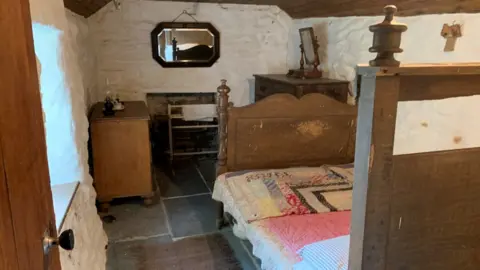
It was once popular with visitors, but has been largely unused in recent years and is now only accessible by appointment via the council.
The building is listed and some repair work needs to be completed, but no council funding is currently available.
However, those anxious to maintain it are to call a meeting at the village hall next month to discuss the way ahead.
It is hoped a new group, called Friends of Penrhos, can be created to attract grants and others keen to help.

Local author and journalist Hefin Wyn is optimistic about the future.
"It is an absolute treasure," he said.
"It was built originally as a 'one night house' and that suggests that things were pretty poor in the area in those days, around the time of the Rebecca Riots.
"We have to remind ourselves of the hardship that was faced by the farmers in that period.
"Penrhos should be open, so there have been some conversations.
"Lots of people are interested and there are lots of volunteers ready.
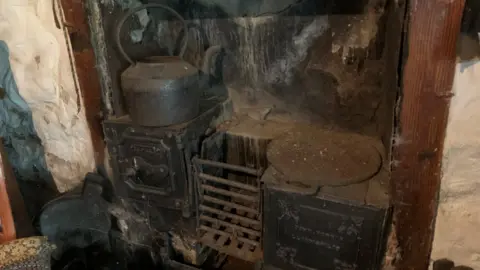
"We'll have to look for money from some other institutions to get it up to scratch so we can invite people to visit the place.
"I'm sure after we've done the work, we can have volunteers here at certain times of the week to welcome people and tell them the old story about the place and who lived there."
Pembrokeshire Council said it was "open to working with a constituted working group to preserve this important building and make it more accessible".

- WALES' HOME OF THE YEAR: Which home will be crowned the winner?
- BAFTA CYMRU WINNERS: Check out these award winning shows

